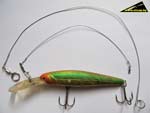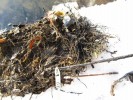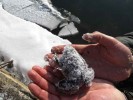The spinning lure retriever “Omout” is designed for releasing lures of any kind from catches. You can use it for fishing from the boat or from the bank. It helps even with catches at a significant distance, retrieving the lure without any damage to it and without scarring off the fish. Taking into account that its price doesn’t exceed the price of one branded wobbler, this lure retriever will pay off after just a few fishings. And then it starts to save your money, saving your favorite lucky lures and allowing you to fish in places, where others just won’t dare to fish! And you may also retrieve someone else’s lures together with a snag or a net.
I was designing and improving this lure retriever for over 10 years. And it really works! IT’S THE BEST FOR OBJECTIVE REASONS! And I can tell you this as a fisherman to a fisherman and prove my words with the abovementioned!
There is also a video about all this with the examples of the retriever's performance in real conditions. Unfortunately, it is available only in Russian at the moment, but I think that a fisherman will understand everything even without translation.
How to use it
Let’s regard using the retriever when fishing from the bank, as it’s a bit more difficult than when we fish from a boat and can just come up closer if necessary. The main thing is that there’s no need to set the boat right above the catch. And it’s very useful – given that a snag (that’s just caught your lure) may be a home of your trophy!
1. Lean the rod on a bush, lay it on the bank, place it under arm…whatever you like. I usually lean it on my back. Take the retriever and thread the line through the clip in the front part of it. The line must go to the lure from the side of the clip.

2. Open the loop at the back side of the retriever, thread the line through it and hook it up.
The retriever is ready-to-go!

3. Now we have to deliver the retriever to the lure. Here I should mention that the retriever goes the farther the higher you rise the line (the higher the angle is) and the thinner the retriever rope is (IВот несколько фотографий с той рыбалки. use the 0,45 mm braided line). Though there are some tricks that allow doing with a thick rope – you’ll find them at our web-site. If the retriever is far away, you should make the angle of the line entering the water maximal. Try to climb higher or use the rod if it is strong enough. If not then raise your hand with the rod higher. Making some tugs at the end is also useful – thus will help the retriever to overcome obstacles, ‘cause we don’t know what’s there in the water…
4. Begin getting the retriever out of water –do it with a strained line. It’s not necessary to strain it too much, just keep it tense. Get the retriever out slowly until you feel that it has caught a swivel or lure. Now you can slacken the line. You favorite lure is saved now!
5. Now you only have to pull it a bit harder. The hook will unbend and you will retrieve the lure undamaged.

You can bend most of the hooks and use them again or you can replace it – it’s up to you. Anyway the lure will be saved and the water won’t be contaminated with lead, what’s also important. To tell the truth you may also retrieve the cause of the catch…sometimes even together with someone else’s lures! It often happens when the lure got caught in the net, sack, pieces of rope. As when the lure is caught in such objects the angle of power to the hook is narrower it is often retrieved together with the cause of the catch. Once I pulled out a packet with wallets, drowned by some pickpocket…too bad they were empty!
By the way, the wobbler in the picture had been caught about 7 times, I can’t remember precisely. The thing is that it’s still in my box with lures.
I’m often asked whether some special swivels or tippets are needed – no, they aren’t necessary at all. Moreover, sometimes all you need is a strong quality line. But the line is constantly exposed to the abrasive effect and load, and thus it wears off. And as the result the line tears at the fewer load than was stated. Swivels and tippets aren’t affected by it and the strength of a tippet with the same diameter is much higher, let alone the most popular swivels. For example, here's a photo of a pack of swivels № 10.
Usually, swivels of greater size are used for the tippets which you can find at diffrent shops and stores. But if you still doubt just put an additional swivel between the tippet and the lure.

Though I don't do so myself. I do with simple swivels, tippets and swivelling hooks.
By the way, the wobbler which I've used for this example is so to say a "trophy" one. I got it out of water together with a piece of a net, when I was retrieving my lure.It appeared to be a lucky one and I've caught a whole lot of fish with it. Unfortunately, I still don't know which model it is and what's its producer.
And the last thing – an event that had happened the day I wrote this article.
We decided to go fishing – and as it was in winter (in February) we went to the Svisloch river. It doesn’t freeze up because of warm waters even when it’s frosty, giving an opportunity to do our thing.
A catch happened at one pit. It’s a usual thing at Svisloch, especially in the city line. Besides common causes of catches there is a whole lot of rubbish dumped into the river by people.
So I had to use the retriever…and I was already feeling the cause of the catch slowly move in my direction. It turned out to be an old net which had drowned before the winter as judged by the amount of trash in it. Well, quite usual.
I threw it on the bank and began to explore it in order to find any lures. Sometimes you can find some lures lost by your less lucky fishing “colleagues” to add to your lure box. And at that moment I noticed that the net began to move. I opened out the mesh and saw…a frog! It piled in into the net in autumn - for wintering. How should the poor thing have known that its home would be caught by a fisherman in winter? And he wouldn’t tear off the plunker, but would get it out of water together with the shelter with a retriever. I couldn’t help taking the frog in hands. And it began to sing – maybe because of the warmth of my hands, or maybe for some frog reasons. Just imagine – it’s winter, -8°C, and there’s a singing frog in my hands, all covered with snow. Though its signing wasn’t too loud, it was quite distinctive. But we didn’t listen to it for long – we were afraid of freezing this guest from summer, so we let her go into the water.
Here are some photos from that day:






